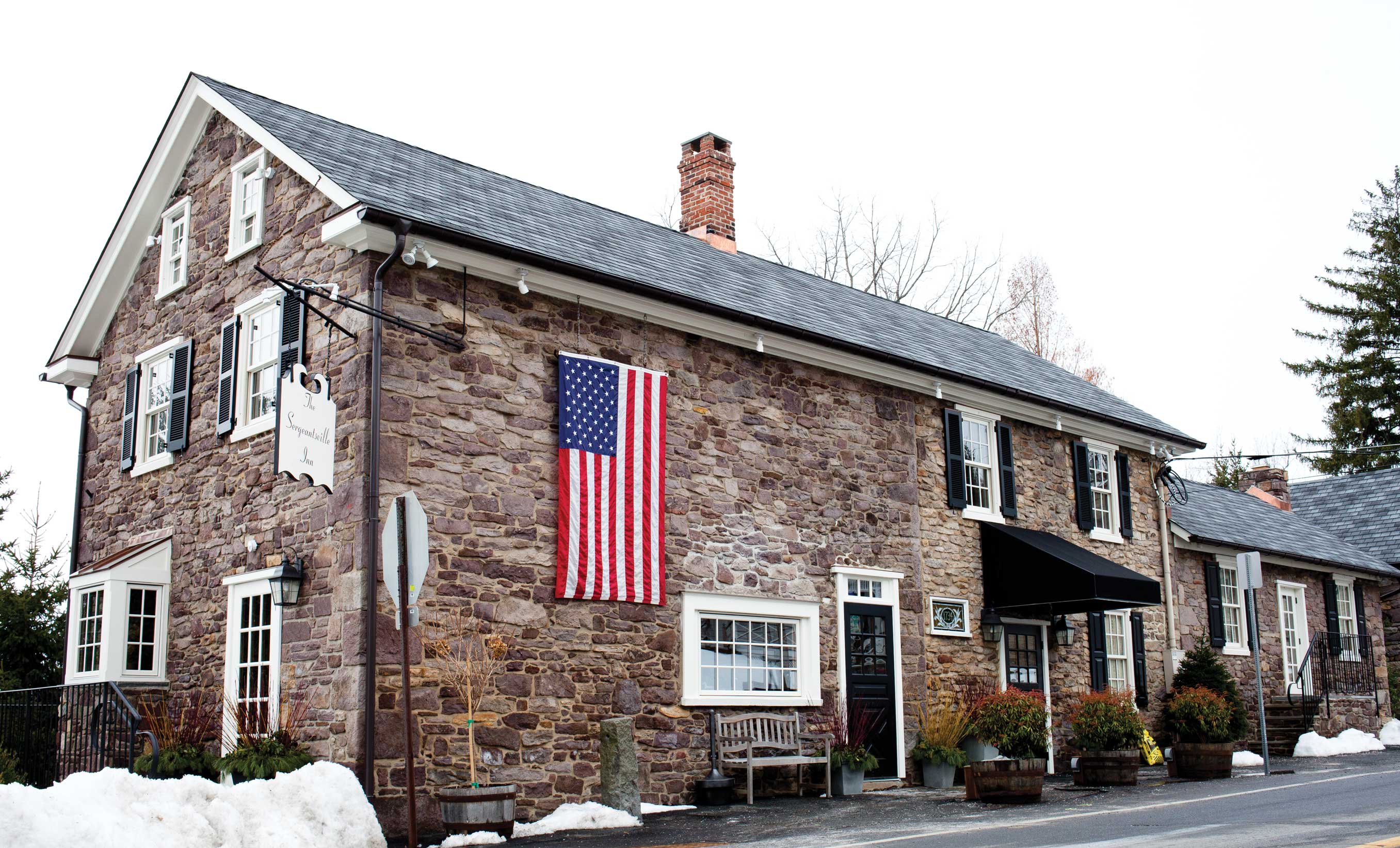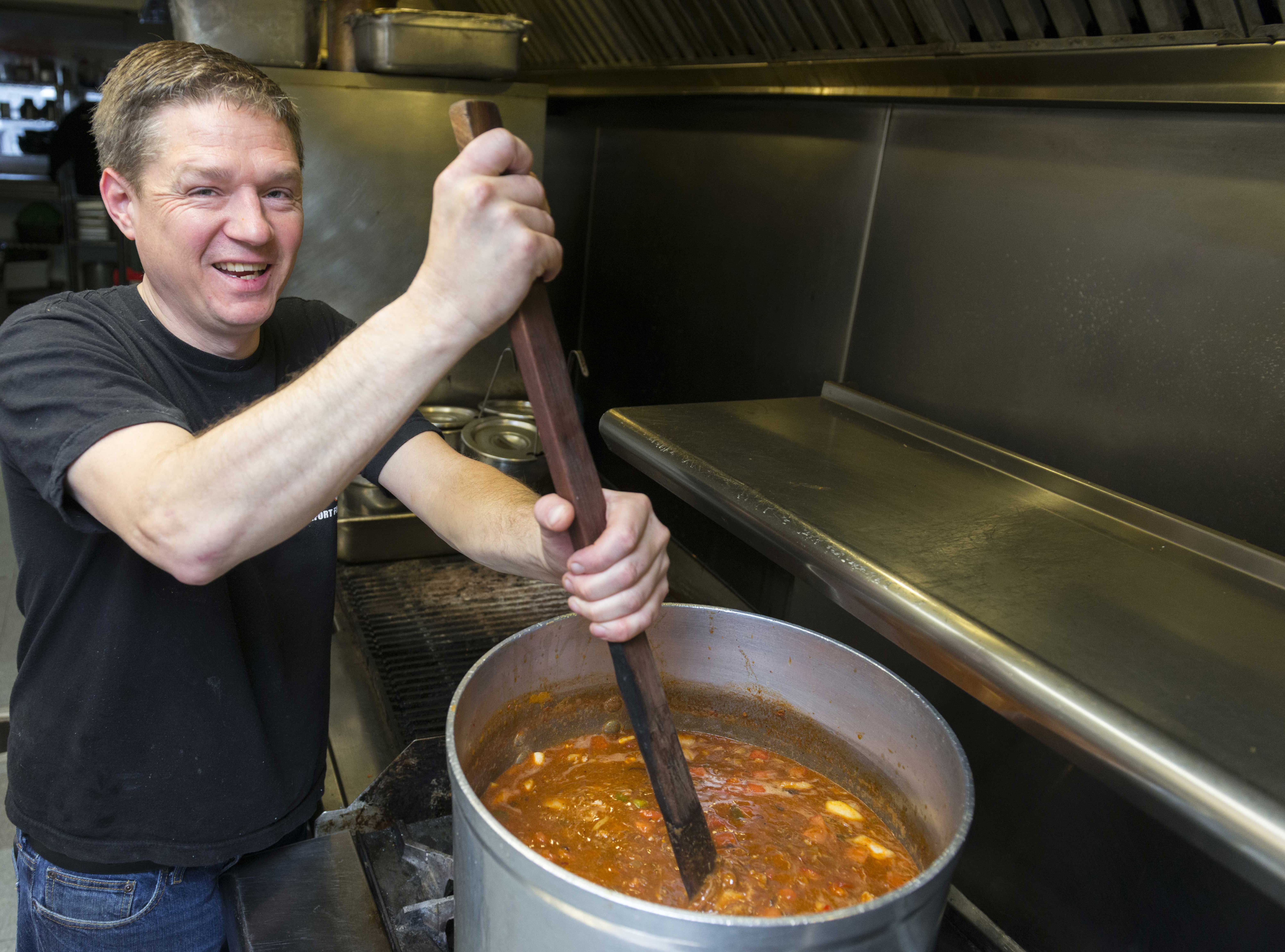
It Took a Village

DINING OUT
Fire burned the Sergeantsville Inn down to its 300-year-old shell one night last winter. A community rebuilt it in nine months. And overnight, normalcy settled back in, inside the restaurant and out.
By Scott Edwards · Photography by Josh DeHonney

Much of the wood throughout was salvaged from the building and donated by neighbors. Top: The inn, 11 months after the fire. Below , Lisa and Joe Clyde, home at last.
 As a cold dawn filled the sky on March 9, 2015, the last wisps of smoke from a fast-moving fire were doused. Sometime after the Sergeantsville Inn closed for the night, an electrical fire broke out in the waiters’ station adjacent to the bar. The response would run to four alarms, drawing 18 companies from New Jersey and Pennsylvania. Come the morning, all that remained standing of the 18th-century building were the fieldstone walls and a room at the western end that once served as the ice house for the Central New Jersey village, which sits perched atop a hill, about a 10-minute drive north of New Hope. The fire spared the room entirely.
As a cold dawn filled the sky on March 9, 2015, the last wisps of smoke from a fast-moving fire were doused. Sometime after the Sergeantsville Inn closed for the night, an electrical fire broke out in the waiters’ station adjacent to the bar. The response would run to four alarms, drawing 18 companies from New Jersey and Pennsylvania. Come the morning, all that remained standing of the 18th-century building were the fieldstone walls and a room at the western end that once served as the ice house for the Central New Jersey village, which sits perched atop a hill, about a 10-minute drive north of New Hope. The fire spared the room entirely.
The inn, which was bought in 1999 by Joe Clyde, who’s also the executive chef, had an especially loyal following. (Including me and my wife. We moved to Sergeantsville a little more than two years before the fire, and we were gravitating there more and more.) Within days of the fire, a “Save the Inn” Facebook page went up, and it would evoke nearly 4,800 likes. Joe says he and his wife, Lisa, who manages the front of the restaurant, knew “probably the next day, after the shock wore off” that they’d rebuild. The actual reconstruction, led by Barna Building Contractors, based the next town over, in Stockton, was as swift and sure. Over the next nine months, the building was hollowed out and then pieced back together.
Amid the December holidays, the Sergeantsville Inn reopened gradually, looking different, of course, but surprisingly the same in more ways. Mik Barna, the builder, salvaged every part of the building that he could. The attic floorboards that weren’t burned were pulled up, replaced with plywood and repurposed throughout the restaurant. And when Barna fell short, the neighbors covered the gaps, donating wood from their old barns. Another offered up a fallen black walnut tree, from which the new bar was crafted. When I meet with the Clydes at the restaurant in the last days of December, it’s covered in a temporary, white Formica countertop that’s filled with short, supportive messages scrolled in a rainbow of Sharpie ink.
Joe seized the chance to upgrade the kitchen. He describes the former space as “a cave with ovens.” He stands less than six feet tall, but he always wore a baseball hat to keep from scraping his head on the ceiling. An excavator dug two feet down to add some height. The walk-in refrigerators were also moved outside.
They’re hidden, for the most part, by a modest deck that’ll hold a few tables come the spring. Central air and heat were added. Little could be done about the unfavorable footprint, but Joe, at least, bought himself and his crew some breathing room and climate control. Not that anyone seemed all that fazed by the way things were. Most of the staff—cooks, waiters, bartenders—have been by his side for at least a decade. And every one of them returned. Nearby restaurants offered to employ them until the inn reopened.
Upstairs, the tavern, once a rather cozy room in its own right, now opens to the roofline. A second-floor apartment that Joe used occasionally was converted to another, three-wall seating area—about 70 seats were added altogether—that extends halfway over the tavern, creating a loft-like space.
 When I ask Lisa and Joe if anything meaningful couldn’t be saved or replaced, they pause. Grateful as they are to have their restaurant (and everyone in it) back, they’re humble, soft-spoken people. Routine is what they know best, and the last several months were profoundly disorienting. Joe looks across the table, says, “My father’s wedding ring.” It was lost shortly before his father died. Joe found it, kept it in the second-floor apartment. During the demolition, they gave the crew an idea of where it could be, not really expecting it to be there. It was gone, they knew. But then the builder’s son, Mik Barna Jr., turned up with it. So, no, nothing meaningful was lost.
When I ask Lisa and Joe if anything meaningful couldn’t be saved or replaced, they pause. Grateful as they are to have their restaurant (and everyone in it) back, they’re humble, soft-spoken people. Routine is what they know best, and the last several months were profoundly disorienting. Joe looks across the table, says, “My father’s wedding ring.” It was lost shortly before his father died. Joe found it, kept it in the second-floor apartment. During the demolition, they gave the crew an idea of where it could be, not really expecting it to be there. It was gone, they knew. But then the builder’s son, Mik Barna Jr., turned up with it. So, no, nothing meaningful was lost.
Sergeantsville Inn, 601 Rosemont Ringoes Road, Sergeantsville, NJ; sergeantsvilleinn.com.












